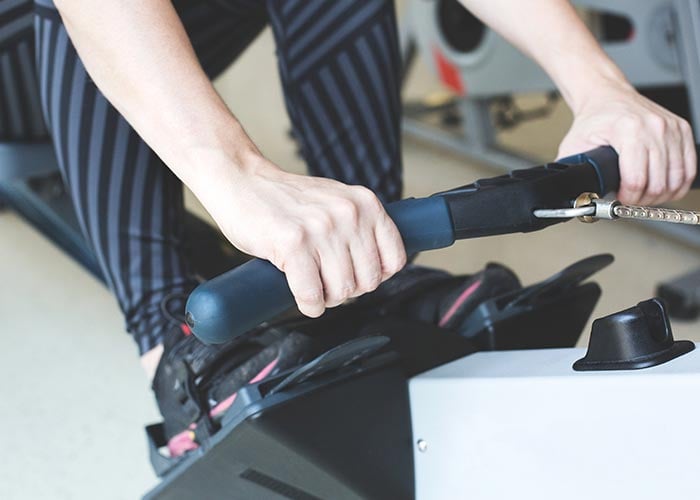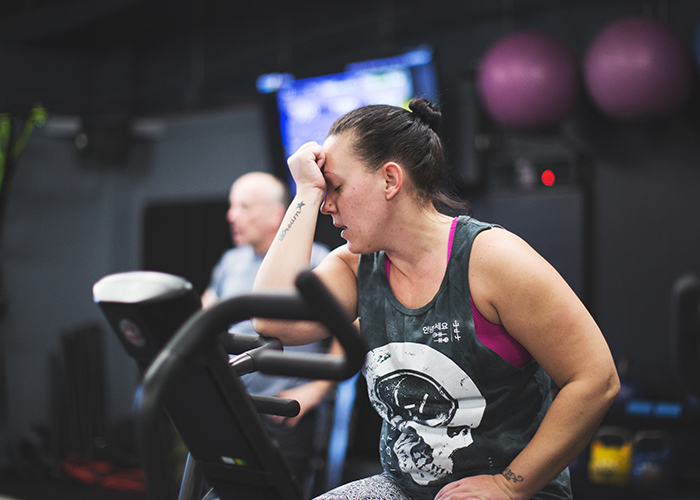As you probably know by now, a popular theme at Myzone is High-Intensity Interval Training (HIIT). Perfect for training with a heart rate monitor, HIIT has regularly ranked as the number one fitness trend in the world, according to the American College of Sports Medicine.
This blog post is dedicated to explaining HIIT ratios and providing you with sample HIIT workouts for beginners and advanced exercisers.
HIIT Definition:
HIIT consists of phases of high-intensity work, followed by phases of moderate or low-intensity recovery. Relative to Myzone heart rate zones, the work phase would take place in the yellow or red zones, and the recovery phase would take place in the green or blue zones.
The duration and number of your work and recovery phases you perform will depend on your fitness level and training goals. When performing HIIT, research suggests that the range of work and recovery for each interval be 15 seconds up to 2-3 minutes in duration (depending on the ratio of work-to-recovery used).
The total duration of a HIIT session should be about 30-60 minutes in length, with warm up and cool down included in that time.

HIIT Ratios:
As written above, each high-intensity interval consists of a work phase and recovery phase. The HIIT ratio is the amount of time spent working vs the amount of time spent recovering, also known as the work-to-recovery ratio. For example, when you perform 60 seconds of work followed by 60 seconds of recovery, your HIIT ratio is 1-to-1.
When starting a HIIT program, we recommend using HIIT ratios with longer recovery phases than work phases. For example, a 1-to-3 work-to-recovery ratio is a good starting point.
The goal in HIIT is to push hard during the work phase and recover as much as possible during the recovery phase. When you're developing your fitness, it's beneficial to have a longer recovery period so you can work as hard as possible during the work phase of each interval.
As your fitness level improves, you can increase the work-to-recovery ratio and aim for a 1-to-1 ratio. Eventually, you can extend the work phase for a longer duration than the recovery phase; advanced HIIT participants can aim for ratios of 3-to-1 work-to-recovery.
Make sure you're hitting your target zones during the work and recovery phase before you progress your ratios. For example, if your goals is to be in yellow on the work phase and green on the recovery phase using a 1-to-3 ratio, make sure you reach those goals before you progress your ratio to a 1-to-2 work-to-recovery.
Choose the number of interval sets performed based on your ability to hit your target work and recovery zones. In general, 8 to 12 interval sets are sufficient, depending on the duration of each interval.
Below is a sample progression of work-to-recovery HIIT ratios over 5 months:
Week 1 through 4: 1-to-3 Ratios
Week 1: 15 seconds work: 45 seconds recovery
Week 2: 20 seconds work: 60 seconds recovery
Week 3: 30 seconds work: 90 seconds recovery
Week 4: 30 seconds work: 90 seconds recovery
Week 5 through 8: 1-to-2 Ratios
Week 5: 15 seconds work: 30 seconds recovery
Week 6: 20 seconds work: 40 seconds recovery
Week 7: 30 seconds work: 60 seconds recovery
Week 8: 30 seconds work: 60 seconds recovery
Weeks 9 through 12: 1-to-1 Ratios
Week 9: 15 seconds work: 15 seconds recovery
Week 10: 20 seconds work: 20 seconds recovery
Week 11: 30 seconds work: 30 seconds recovery
Week 12: 45 seconds work: 45 seconds recovery
Weeks 13 through 16: 2-to-1 Ratios
Week 13: 30 seconds work: 15 seconds recovery
Week 14: 40 seconds work: 20 seconds recovery
Week 15: 60 seconds work: 30 seconds recovery
Week 16: 90 seconds work: 45 seconds recovery
Weeks 17 through 20: 3-to-1 Ratios
Week 17: 30 seconds work: 10 seconds recovery
Week 18: 45 seconds work: 15 seconds recovery
Week 19: 60 seconds work: 20 seconds recovery
Week 20: 90 seconds work: 30 seconds recovery
Keep moving forward!
Remember to use the hashtags #effortrewarded and #myzonemoves when you post your workout pics.
If you're new to Myzone, you can find out more about the MZ-Switch, the world's first interchangeable heart rate monitor for the gym, outdoors, and in water – here.
Share this
You May Also Like
These Related Stories

5 Tips For High Intensity Exercise Motivation

Organizing Your HIIT to Maximize Benefits!


